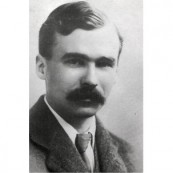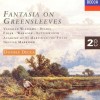| Country: | United Kingdom |
| Period: | Romantique |
Biography
George Sainton Kaye Butterworth, MC (12 July 1885 – 5 August 1916) was an English composer best known for the orchestral idyll The Banks of Green Willow and his song settings of A. E. Housman's poems from A Shropshire Lad
Butterworth was born in Paddington, London.[2] Soon after his birth, his family moved to Yorkshire so that his father Sir Alexander Kaye Butterworth could take up an appointment as general manager of the North Eastern Railway, based at York.[1] George received his first music lessons from his mother, who was a singer, and he began composing at an early age.[1] As a young boy, he played the organ for services in the chapel of his prep school, Aysgarth School, before gaining a scholarship to Eton College.[1][3] He showed early musical promise at Eton, a 'Barcarolle" for orchestra being played during his time there (it is long since lost).[4] He then went to Trinity College, Oxford, where he became more focused on music, becoming President of the university musical society.[1] He also made friends with folk song collector Cecil Sharp; the composer and folk song enthusiast Ralph Vaughan Williams; the future Director of the Royal College of Music, Hugh Allen; and a baritone singer and future conductor, Adrian Boult. Butterworth and Vaughan Williams made several trips into the English countryside to collect folk songs (Butterworth collected over 450 himself, many in Sussex in 1907, and sometimes using a phonograph) and the compositions of both were strongly influenced by what they collected.[1] Butterworth was also an expert folk dancer, being particularly keen in the art of morris dancing.[1] In fact, he was employed for a while by the English Folk Dance and Song Society (of which he was a founder member in 1906) as a professional morris dancer, a member of the Demonstration Team.[1]
Upon leaving Oxford, Butterworth began a career in music, writing criticism for The Times, composing, and teaching at Radley College, Oxfordshire.[1] He also briefly studied piano and organ at the Royal College of Music where he worked with Hubert Parry among others, though he stayed less than a year as the academic life was not for him.[1]
Vaughan Williams and Butterworth became close friends. It was Butterworth who suggested to Vaughan Williams that he turn a symphonic poem he was working on into his London Symphony. Vaughan Williams recalled:
We were talking together one day when he said in his gruff, abrupt manner: ‘You know, you ought to write a symphony’. I answered...that I’d never written a symphony and never intended to...I suppose Butterworth’s words stung me and, anyhow, I looked out some sketches I had made for...a symphonic poem about London and decided to throw it into symphonic form...From that moment, the idea of a symphony dominated my mind. I showed the sketches to George bit by bit as they were finished, and it was then that I realised that he possessed in common with very few composers a wonderful power of criticism of other men’s work and insight into their ideas and motives. I can never feel too grateful to him for all he did for me over this work and his help did not stop short at criticism.[5]
When the manuscript for that piece was lost (having been sent to Germany, either to the conductor Fritz Busch or for engraving, just before the outbreak of war), Butterworth, together with Geoffrey Toye and the critic Edward J. Dent, helped Vaughan Williams reconstruct the work.[6] Vaughan Williams dedicated the piece to Butterworth's memory after his death.
At the outbreak of the First World War, Butterworth (together with several friends including Geoffrey Toye and R. O. Morris) joined the British Army as a Private in the Duke of Cornwall's Light Infantry, but he soon accepted a commission as a Subaltern (2nd Lieutenant) in the 13th Battalion Durham Light Infantry, and he was later temporarily promoted to Lieutenant.[1] He was known as G. S. Kaye-Butterworth in the army.[1] Butterworth's letters are full of admiration for the ordinary miners of County Durham who served in his platoon. As part of 23rd Division, the 13th DLI was sent into action to capture the western approaches of the village of Contalmaison on The Somme. Butterworth and his men succeeded in capturing a series of trenches near Pozières on 16–17 July 1916, the traces of which can still be found within a small wood, although Butterworth was slightly wounded in the action. For it Temporary Lt George Butterworth, aged 31, was awarded the Military Cross, gazetted 25 August 1916,[7] although he did not live to receive it.
The Battle of the Somme was now entering its most intense phase. On 4 August, 23rd Division was ordered to attack a communication trench known as Munster Alley that was now in German hands. The soldiers dug an assault trench and named it 'Butterworth Trench' in their officer's honour. In desperate fighting during the night of 4–5 August, Butterworth and his miners captured and held on to Munster Alley, albeit with heavy losses and despite 'friendly fire' from Australian artillery. At 0445 on 5 August, amid frantic German attempts to recapture the position, Butterworth was shot through the head by a sniper. He was hastily buried by his men in the side of the trench, but his body was lost in the fierce bombardments of the next two years. The following morning the same trench was the site of Private William Henry Short's (Yorkshire Regiment) act of gallantry which was to win him a posthumous Victoria Cross.
When his brigade commander, Brigadier General Page Croft, wrote to Butterworth's family to inform them of his death, it transpired that they had not known that he had earlier been awarded the Military Cross.[1] And likewise, the Brigadier was astonished to learn that Butterworth had been the most promising young English composer of his generation.[1] The Brigadier wrote that Butterworth was; "A brilliant musician in times of peace, and an equally brilliant soldier in times of stress."[8] There is confusion sometimes about exactly what Butterworth was awarded. It is often said that he won the MC twice. That is not correct, but the misunderstanding may have arisen because Butterworth was notable for his bravery in July 1916. Firstly, he was mentioned in despatches early in the month, then he was recommended for the MC "for conspicuous gallantry in action" on 9 July at Bailiff Wood, then again "for commanding his company with great ability and coolness" when wounded on 16–17 July (this was the action for which he was awarded the MC), and Brigadier Page-Croft wrote to Sir Alexander after Butterworth's death that he had 'won' the medal again on the night he died, but since the Military Cross was not awarded posthumously at the time, he could never have been awarded it.
Butterworth's body was never recovered (although his unidentified remains may well lie at nearby Pozieres Memorial, a Commonwealth War Graves Commission cemetery), and his name appears on the Thiepval Memorial.[1] George Butterworth's The Banks of Green Willow has become synonymous for some with the sacrifice of his generation and has been seen by some as an anthem for all 'Unknown Soldiers'. Sir Alexander Butterworth erected a plaque at St Mary's Priory Church, Deerhurst, Gloucestershire in memory of his son and of his nephew, Hugh, who died at Loos in 1915. (Rev. George Butterworth, the composer's grandfather, had been vicar of St Mary's in the previous century.[1]) Sir Alexander also arranged the printing in 1918 of a memorial volume in his son's memory. Almost all Butterworth's manuscripts were left to Vaughan Williams, after whose death Ursula Vaughan Williams lodged the original works in the Bodleian, Oxford, and the folk song collection with the EFDSS.







